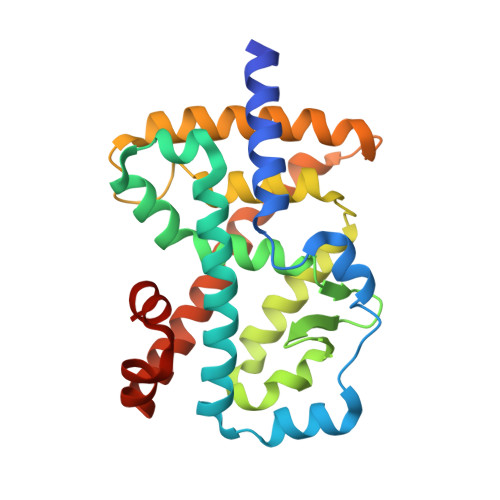X-ray structure of the orphan nuclear receptor RORbeta ligand-binding domain in the active conformation.
Stehlin, C., Wurtz, J.M., Steinmetz, A., Greiner, E., Schule, R., Moras, D., Renaud, J.P.(2001) EMBO J 20: 5822-5831
- PubMed: 11689423
- DOI: https://doi.org/10.1093/emboj/20.21.5822
- Primary Citation of Related Structures:
1K4W - PubMed Abstract:
The retinoic acid-related orphan receptor beta (RORbeta) exhibits a highly restricted neuronal-specific expression pattern in brain, retina and pineal gland. So far, neither a natural RORbeta target gene nor a functional ligand have been identified, and the physiological role of the receptor is not well understood. We present the crystal structure of the ligand-binding domain (LBD) of RORbeta containing a bound stearate ligand and complexed with a coactivator peptide. In the crystal, the monomeric LBD adopts the canonical agonist-bound form. The fatty acid ligand-coactivator peptide combined action stabilizes the transcriptionally active conformation. The large ligand-binding pocket is strictly hydrophobic on the AF-2 side and more polar on the beta-sheet side where the carboxylate group of the ligand binds. Site-directed mutagenesis experiments validate the significance of the present structure. Homology modeling of the other isotypes will help to design isotype-selective agonists and antagonists that can be used to characterize the physiological functions of RORs. In addition, our crystallization strategy can be extended to other orphan nuclear receptors, providing a powerful tool to delineate their functions.
Organizational Affiliation:
Laboratoire de Biologie et Génomique Structurales (CNRS Unité Propre de Recherche 9004), Institut de Génétique et de Biologie Moléculaire et Cellulaire (CNRS/INSERM/Université Louis Pasteur), 1 rue Laurent Fries, BP 163, 67404 Illkirch, France.
















